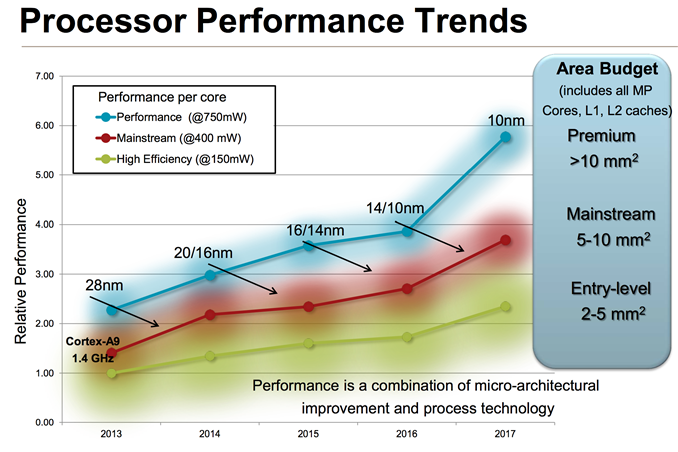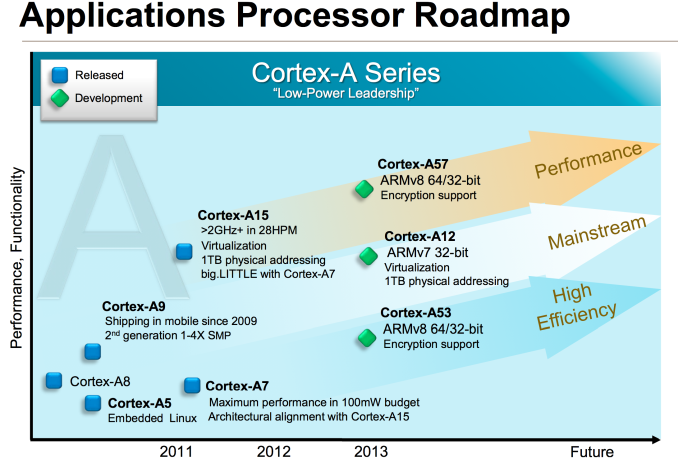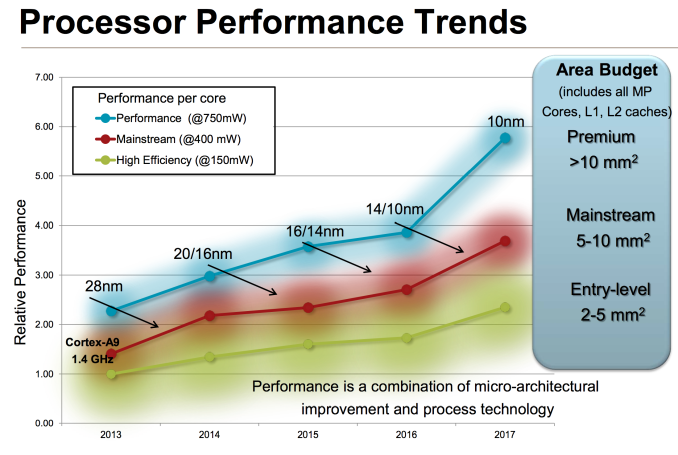The ARM Diaries, Part 2: Understanding the Cortex A12
by Anand Lal Shimpi on July 17, 2013 12:30 PM EST- Posted in
- CPUs
- Arm
- SoCs
- Cortex A12

A couple of weeks ago I began this series on ARM with a discussion of the company’s unique business model. In covering semiconductor companies we’ve come across many that are fabless, but it’s very rare that you come across a successful semiconductor company that doesn’t even sell a chip. ARM’s business entirely revolves around licensing IP for its instruction set as well as its own CPU (and now GPU and video) cores.
Before we get into discussions of specific cores, it’s important to talk about ARM’s portfolio as a whole. In the PC space we’re used to focusing on Intel’s latest and greatest microarchitectures, which are then scaled in various ways to hit lower price targets. We might see different core counts, cache sizes, frequencies and maybe even some unfortunate instruction set tweaking but for the most part Intel will deliver a single microarchitecture to cover the vast majority of the market. These days, this microarchitecture is simply known as Core.
Back in 2008, Intel introduced a second microarchitecture under the Atom brand to target lower cost (and lower power) markets. The combination of Atom and Core spans the overwhelming majority of the client computing market for Intel. The prices of these CPUs range from the low double digits with Atom to many hundreds of dollars for the highest end Core processors (the most expensive desktop Haswell is $350, however mobile now extends up to $1100). There are other designs that target servers (which are then repurposed for ultra high-end desktops), but those are beyond the scope of this discussion for now.
If we limit our discussion to personal computing devices (smartphones, tablets, laptops and desktops), where Intel uses two microarchitectures ARM uses three. The graphic below illustrates the roadmap:
You need to somewhat ignore the timescale on the x-axis since those dates really refer to when ARM IP is first available to licensees, not when products are shipping to consumers, but you get an idea for the three basic vectors of ARM’s Cortex A-series of processor IP. Note that there are also Cortex R (embedded) and Cortex M (microcontroller) series of processor IP offered as well, but once again those are beyond the scope of our discussion here.
If we look at currently available cores, there’s the Cortex A15 on the high end, Cortex A9 for the mainstream and Cortex A7 for entry/low cost markets. If we’re to draw parallels with Intel’s product lineup, the Cortex A15 is best aligned with ultra low power/low frequency Core parts (think Y-series SKUs), while the Cortex A9 vector parallels Atom. Cortex A7 on the other hand targets a core size/cost/power level that Intel doesn’t presently address. It’s this third category labeled high efficiency above that Intel doesn’t have a solution for. This answers the question of why ARM needs three microarchitectures while Intel only needs two: in mobile, ARM targets a broader spectrum of markets than Intel.
Dynamic Range
If you’ve read any of our smartphone/tablet SoC coverage over the past couple of years you’ll note that I’m always talking about an increasing dynamic range of power consumption in high-end smartphones and tablets. Each generation performance goes up, and with it typically comes a higher peak power consumption. Efficiency improvements (either through architecture, process technology or both) can make average power in a reasonable workload look better, but at full tilt we’ve been steadily marching towards higher peak power consumption regardless of SoC vendor. ARM provided a decent overview of the CPU power/area budget as well as expected performance over time of its CPU architectures:
Looking at the performance segment alone, we’ll quickly end up with microarchitectures that are no longer suited for mobile, either because they’re too big/costly or they draw too much power (or both).
The performance vector of ARM CPU IP exists because ARM has its sights set higher than conventional smartphones. Starting with the Cortex A57, ARM hopes to have a real chance in servers (and potentially even higher performance PCs, Windows RT and Chrome OS being obvious targets).
Although we see limited use of ARM’s Cortex A15 in smartphones today (some international versions of the Galaxy S 4), it’s very clear that for most phones a different point on the power/performance curve makes the most sense.
The Cortex A8 and A9 were really the ARM microarchitectures that drove smartphone performance over the past couple of years. The problem is that while ARM’s attentions shifted higher up the computing chain with Cortex A15, there was no successor to take the A9’s place. ARM’s counterpoint would be that Cortex A15 can be made suitable for lower power operation, however its partners (at least to date) seemed to be focused on extracting peak performance from the A15 rather than pursuing a conservative implementation designed for lower power operation. In many ways this makes sense. If you’re an SoC vendor that’s paying a premium for a large die CPU, you’re going to want to get the most performance possible out of the design. Only Apple seems to have embraced the idea of using die area to deliver lower power consumption.
The result of all of this is that the Cortex A9 needed a successor. For a while we’d been hearing about a new ARM architecture that would be faster than Cortex A9, but lower power (and lower performance) than Cortex A15. Presently, the only architecture in between comes from Qualcomm in the form of some Krait derivative. For ARM to not let its IP licensees down, it too needed a solution for the future of the mainstream smartphone market. Last month we were introduced to that very product: ARM’s Cortex A12.
Slotting in numerically between A9 and A15, the initial disclosure unfortunately didn’t come with a whole lot of actual information. Thankfully, we now have some color to add.












65 Comments
View All Comments
crypticsaga - Wednesday, July 17, 2013 - link
Is it just me or have the arm architecture reviews become more interesting than the intel or amd ones?WhitneyLand - Wednesday, July 17, 2013 - link
Your tastes are changing. I used to read power supply and case reviews, now I usually don't even peek at the summary. I guess you could say some people are interested in where the action is, and while Intel is making bold moves (I still read Intel articles) there are still many things that we already know from previous reviews. ARM is still novel to us.jeffkibuule - Monday, July 22, 2013 - link
They are constantly evolving. Intel isn't experiencing hyper growth in performance anymore, instead optimizing for power which is far less sexy.lilmoe - Wednesday, July 17, 2013 - link
Cortex A12 is too late to the game. Too frustratingly so.name99 - Wednesday, July 17, 2013 - link
What game is that? ARM is in the business of making money. It will sell hundreds of millions of these to the developing world, and make money on each one.If you want to view low-power CPUs as porn, not a business, you should be spending your time watching Apple (and to a lesser extent, Qualcomm and, maybe one-day Intel) not ARM.
lilmoe - Wednesday, July 17, 2013 - link
I'm strictly speaking business, not porn, thank you. To me, Cortex A12 is addressing the same problem that Krait and Swift cores addressed (specifically in memory bandwidth), where competitors are clearly >2 years ahead by the time of availability. Look how "successful" A15 vendors are (/s) while Qualcomm is taking a huge share of the pie.big.LITTLE is proving too hard to implement. Samsung has succeeded in providing Apple with their needs when other fabs failed, all while having difficulties with their implementation of big.LITTLE. Samsung even ditched the CHEAPER licence of ARM's Mali GPU in favor of IT's solution. There's clearly a problem somewhere. Yes, Cortex A15 is faster, but "average" performance of Krait 200 compared with big.LITTLE (a15/a7) is VERY comparable. However, in heavy workloads, Cortex A15 consumes significantly more power.
ARM has this "view" on how the market "should" be heading, while the market is heading in a clearly different power-envelope/performance direction. Reason? Android. Cortex A9 is not powerful enough for Android, and A15 consumes too much power. I'm a big believer in power efficiency, but ARM seriously need to revise their power envelope charts. Cortex A15 should have been a target of the 20/22nm process, NOT 28nm. That's how demand is working now. Cortex A12 SHOULD HAVE BEEN prioritized over Cortex A15 on 28nm. OEMs (including Samsung) are preferring Snapdragons over Exynos 5 and Tegra 4 even on more power tolerable devices like tablets.
That said, even they're high performance Cortex A15 is seriously threatened by Krait 300 and Silvermont cores in power efficiency at relative performance. And by the time A57 is implemented, where do you think the competition will be?
Someday Intel? Dude, for $400, can either get a Windows RT ARM tablet, or a FULL Windows 8 tablet running Saltwell (and Silvermont in the very near future), which one would you pick? Android tablet you say? Guess what Samsung is doing now with their Tab 3 10.1.
Developing countries? Don't worry about those, Krait 200 cores will be too darn cheap in 2 years when A12 is ready to ship. Oh, they also have modem integration......
The business world works VERY differently from the world enthusiasts live in...
aryonoco - Wednesday, July 17, 2013 - link
You make very valid points, but you have a very developed-world-centric point of view.Yes A12 is too late, it is a response to Swift and Krait, and it is over two years too late. We'll have to wait a while still of course to see how it stacks up against its competition in 2015, but I agree with you in that it should have been prioritized, and it's late.
What you are missing however is that there is a huge swath of the market where ARM doesn't really have a competition. Swift and Krait are non-entities there, they are too expensive for your average Chinese OEM like Zopo or THL or Cube or FAEA (or many dozen others). These phones and tablets are now ruling China, India and south-east Asia, and they are all using Mediatek Cortex A7s in the phones, and Rockchip or Allwinner Cortex A9s in their tablets and Android sticks. These are huge markets, we are talking over 3.5 Billion people who live in these countries, and yes Samsung and Apple sell their phones there as well, but they are tiny (especially Apple). Something like 37% of ARM's Cortex A chips were produced by Mediatek alone in 2012, and no one in the developed world has even heard of them.
Sure Qualcomm is trying to play in this market, with their confusingly named Snapdragon S4 Play (which is just a cortex A5) but Mediatek beats it hands down both in performance and price. Modem integration you say? It just isn't a factor. They all have single band HSPA modems on 2100 Mhz, or at best dual band 850/2100 or 900/2100 and that's all that these markets care about. Oh and dual SIM, they really care about their dual SIM. No one cares about Qualcomm's fancy pants LTE modems, there are no networks to use them on!
Will you ever see Cortex A12 in a flagship Samsung or Apple or HTC product? Probably not, but that doesn't really matter. You'll see it in hundreds of millions of products that will line up on AliExpress and Taobao and that's where the vast bulk of the market is going to be.
parim - Thursday, July 18, 2013 - link
I completely agree with all your points, the sub 200$ android phone market in India is dominated by MediaTech.All of India is on 2100Mhz HSPA
Qualcomm/nvidia need to reduce their prices by a lot to prevent being completely washed away by the MediaTech Wave
Qwertilot - Thursday, July 18, 2013 - link
The other thing to remember is that ARM aren't in competition with Qualcomm, Apple etc. You could even reasonably argue that the existence of Krait meant they didn't need to cover that niche as urgently as the newer markets that the A15/57 etc can be aimed at.Folk like MediaTech must be a massive long term worry for everyone in the SoC market (and Intel trying to break into it) - at some point (reasonably soon?) the bulk of people even in the developed world might well decide that they've got 'enough' performance and then all those very cheap chips will be waiting to destroy margins. ARM are of course set up not to mind.
aryonoco - Thursday, July 18, 2013 - link
Of course you are right, ARM doesn't really view Krait and Swift as its competition... but just because ARM is happy to license its instruction set doesn't mean they like Krait and Swift. ARM gets a higher initial revenue when it licenses out its instruction set, but after that, the percentage that it gets on shipping Krait and Swift cores is far lower than what it gets from a straight implementation of one of its Cortex A designs... in ARM's ideal world, everyone would be implementing straight from its designs and giving it the higher percentage fee.And yes, MediaTek is a massive worry to everyone the big guys. There is also a price war happening between Chinese companies (Rockchip and Allwinner) and MediaTek (which is Taiwanese) right now, price of highest end products have come down by over a third since the start of the year... you can now buy MT's highest end 1.5 Ghz quad core A7 chip for $8... this is just crazy!
Of course ARM is sitting comfortable at the top, but the one company that can give ARM some headache is Imagination. They've been beating ARM in the embedded GPU space for a good while now, and now that they have a CPU architecture of their own... this is going to get very interesting. In the 90s, MIPS had a far better IPC than ARM, so if Imagination really is set to revive MIPS and get aggressive on price, it will be very interesting to watch, especially with over 95% of Android apps working just fine on MIPS. Pity no one is paying attention to that battle, AnandTech didn't even cover the launch of Warrior.